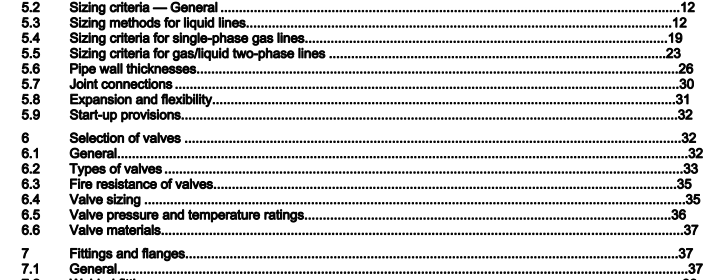BS EN ISO 13703:2001 – This is an uncontrolled copy. Ensure use of the most current version of this standard by searching British Standards Online at bsonline.techindex.co.uk

This International Standard specifies minimum requirements and gives guidance for the design and installation of new piping systems on production platforms located offshore for the petroleum and natural gas industries. It covers piping systems up to 69 000 kPa (ga) maximum, within temperature range limits for the materials meeting the requirements of ASME B31.3. NOTE For applications outside these pressure and temperature ranges, this International Standard may be used but special consideration should be given to material properties. Annex A gives some worked examples for solving piping design problems.
2 Normative references
The following normative documents contain provisions which, through reference in this text, constitute provisions of this International Standard. For dated references, subsequent amendments to, or revisions of, any of these publications do not apply. However, parties to agreements based on this International Standard are encouraged to investigate the possibility of applying the most recent editions of the normative documents indicated below. For undated references, the latest edition of the normative document referred to applies. Members of ISO and IEC maintain registers of currently valid International Standards.
3 Terms, definitions, symbols and abbreviated terms
For the purposes of this International Standard, the following terms, definitions, symbols and abbreviated terms apply.
3.1 Terms and definitions
3.1.1
chloride stress-corrosion cracking service
service in which the process stream contains water and chlorides in a sufficient concentration, and at a high enough temperature, to induce stress-corrosion cracking of susceptible materials
NOTE Other constituents present, such as oxygen (O 2 ), may contribute to such chloride stress-corrosion cracking.
3.1.2
choke
device specifically intended to restrict the flow rate of fluids
3.1.3
corrosion-erosion
eroding away of a protective film of corrosion product by the action of the process stream, exposing fresh metal which then corrodes
NOTE Extremely high metal mass loss can occur under these conditions.
3.1.4 corrosive
gas
gas which, when dissolved in water or other liquid, causes corrosion of metal
NOTE Corrosive gases usually contain hydrogen sulfide (H 2 S), carbon dioxide (CO 2 ) and/or oxygen (O 2 ).
3.1.5
corrosive hydrocarbon service
service in which the process stream contains water or brine and carbon dioxide (CO 2 ), hydrogen sulfide (H 2 S),oxygen (O 2 ) or other corrosive agents under conditions which cause corrosion of metal
3.1.6
expansion bellows
corrugated piping device designed to absorb expansion and contraction
3.1.7
expansion bend
piping configuration designed to absorb expansion and contraction
3.1.8
flowline
piping that carries well fluid from wellhead to manifold or first process vessel
3.1.9
flow regime
flow condition of a multi-phase process stream EXAMPLES Slug flow, mist flow or stratified flow.
3.1.10
fluid
gas, vapour, liquid or combinations thereof
BS EN ISO 13703:2001 – This is an uncontrolled copy. Ensure use of the most current version of this standard by searching British Standards Online at bsonline.techindex.co.uk